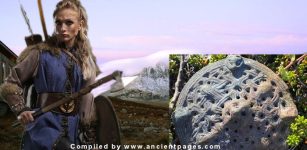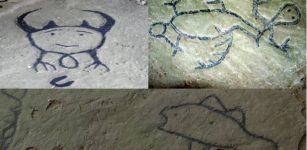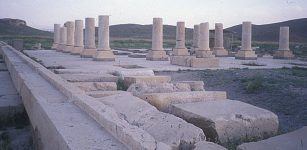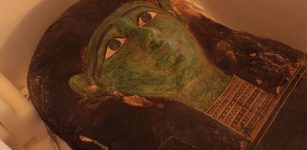Elusive Planet Mercury As Seen Through The Eyes Of Ancient Astronomers
Ellen Lloyd - AncientPages.com - In ancient times the elusive planet Mercury was known under a variety of different names such as Nabu, Thoth, Hermes, Apollo, Buddha and more.
Mercury is the closest planet to the Sun. This hot planet that can reach 840 degrees Fahrenheit (450 degrees Celsius) and it was studied by many ancient astronomers who observed it regulary. It is believed that Mercury was known since at least Sumerian times roughly 5,000 years ago, where it was often associated with Nabu, the god of writing.
Sumerians and Babylonians named Mercury after the god of writing - Nabu
The inhabitants of Mesopotamia from about 3500 B.C. to about 2000 B.C. are referred to as Sumerians.
This civilization developed a written language using signs for words and syllables; their writing is preserved on clay tablets. They are thought to have studied the movements of the Sun, the Moon and the visible planets, although no written records of such observations from this early period remain. In this, as in many other early cultures, the motions of celestial objects were
of great interest because of their religious significance, and particularly because they were thought to give clues about the future course of human events. We now call this belief astrology and distinguish it from astronomy, the scientific study of the heavens.
The Sumerians named the Sun, the Moon and the visible planets - including Mercury - after their greatest seven gods. Translations from surviving cuneiform tablets reveal that Mercury was designated by many names, including that transcribed by archaeologists as MulUDU.IDIM.GU.UD. Mercury was often associated with Nabu, or Ninurta, the god of water and writing. Later, in Akkadian, it became known as Shikhtu, meaning “jumpy”.
The Sumerian civilization was succeeded by the Babylonians, a culture that inherited writing, astronomy, and mathematics from the Sumerians. Early Babylonian astronomers (2000 – 1000 B.C.) may have recorded their observations of the sky: Although no records from that period have survived, tablets from the 7th century B.C. refer to observations of Venus supposedly made much earlier, during the reign of King Ammisaduqa (1702 – 1682 B.C.).
We also know that from 800 B.C. onward the Babylonians cataloged stars, kept records of records of solar eclipses and the time intervals between new moons, and were able to predict some astronomical phenomena.
The Babylonians named Mercury after their divinity Nebo or Nabu, - the record keeper, god of writing, and messenger to the gods. As Mount Sinai in Egypt is named for the Babylonian moon god Sin, Mount Nebo, in present-day Jordan, is named after the Babylonian god of the planet Mercury. In Babylonian astronomy Mercury was associated with both sexes because of its appearance as both an evening and a morning star.
Later Babylonian civilizations (600 B.C. – 200 AD) were yet more advanced in mathematics and astronomy. Their catalog of the stars forms the basis of our zodiac. They also made detailed observations of the movements of the five visible planets, including Mercury.
Mercury was called “Buddha” in ancient India
Astronomers in ancient India believed that the location of the planets in the sky at the time of birth determined a person’s future. The Hindus called the planets collectively “navagrahs” and references to them can be found on temple markings.
As in other early cultures, the planets were given the names of divinities; Mercury was called Budha.
Ancient Chinese called Mercury Chen Xing
In ancient China, Mercury was known as Chen Xing, the Hour Star. It was associated with the direction north and the phase of water in the Wu Xing. Modern Chinese, Korean, Japanese and Vietnamese cultures refer to the planet literally as the "water star", based on the Five elements.
Ancient Egyptians called Mercury - Thoth, the great measurer
Ancient Egyptians were fascinated with the study of the night sky, planets, stars and other celestial bodies.
In ancient Greece Mercury was known under two different names – Apollo and Hermes
Early Greek civilization, from 1400 to 200 BC, made many contributions to astronomy. Unlike other early astronomers who were astrologers as well, Greek astronomers were often considered philosophers and mathematicians, as we know from the works of those such as Plato and Eudoxus.
Around 450 B.C. the Greeks started studying the motions of the planets and using geometry to measure the size of the Earth, Sun and Moon.
See also:
Astronomically Aligned Temples And Pyramids Of Ancient World
Sunduki – “Home Of The Gods” – One Of The World’s Oldest Astronomical Observatories
Mercury was known by two different names, associated with its evening and morning appearances. These were Apollo (god of truth, the arts, archery, plagues, and divination) and Hermes (god of writing and messenger to the other gods). Plato and Eudoxus reported that the synodic and sidereal periods of Mercury were 110 days and 1 year respectively. Later Greek astronomers made detailed star charts and determined planetary motions, often building on earlier work. In 200 AD the Greek astronomer Ptolemy completed his Almagest, a comprehensive text of mathematical astronomy. Translated into Latin around 1400 AD, Ptolemy’s work was considered by Europeans to be the authority on astronomical understanding until the early 1600’s. Ptolemy’s model of the solar system was geocentric, or Earth-centered.
The Sun and planets were thought to travel around the Earth from east to west, with the planets moving on more complicated cyclic paths about their average positions.
The Mayas believed Mercury was just as important as the Sun
Mayan astronomers were primarily interested in the “Zenial Passages” – times when the Sun crossed over certain Mayan latitudes. Mayan astronomy is thought to have developed in the period from 1500 BC to 800 BC. Much of what we know of it is found in writing known as the Dresden Codex, a band of paper 3.5 meters long arranged in 39 sheets. This contains information regarding the calendar system, astronomical data and sky mechanics, as well as tables of multiple integers thought to have been used in the calculations of planetary movements.
The Mayas were also deeply interested in the planet Venus, believing it to be as important as the Sun. But the Mayas charted the motion of the planet Mercury as well; records of their detailed observations are found in the Dresden Codex.
These include the appearance of Mercury as a morning star in 733 B.C. and as an evening star in 727. The Mayans also calculated that Mercury would rise and set in the same place in the sky every 2,200 days.
Written by - Ellen Lloyd – AncientPages.com
Copyright © AncientPages.com All rights reserved. This material may not be published, broadcast, rewritten or redistributed in whole or part without the express written permission of AncientPages.com
Expand for referencesMore From Ancient Pages
-
 Galileo Galilei’ Long-Lost Letter Reveals His Attempt To Fool The Inquisition And Make Science Independent From Religion
Archaeology | Sep 22, 2018
Galileo Galilei’ Long-Lost Letter Reveals His Attempt To Fool The Inquisition And Make Science Independent From Religion
Archaeology | Sep 22, 2018 -
 Ancient Manuscript In Museum Reveals Discovery Of Objects Unknown To Modern Science – Coptic Secrets And Guardians Of Treasures – Part 2
Ancient Mysteries | Apr 11, 2021
Ancient Manuscript In Museum Reveals Discovery Of Objects Unknown To Modern Science – Coptic Secrets And Guardians Of Treasures – Part 2
Ancient Mysteries | Apr 11, 2021 -
 Unique Viking Age Runestone With A Cross And Animal Biting Its Own Tail Discovered By Farmer In Sweden
Archaeology | Sep 20, 2020
Unique Viking Age Runestone With A Cross And Animal Biting Its Own Tail Discovered By Farmer In Sweden
Archaeology | Sep 20, 2020 -
 Fascinating Discovery – First Female Viking Grave Discovered In Swedish Mountains
Archaeology | Aug 20, 2022
Fascinating Discovery – First Female Viking Grave Discovered In Swedish Mountains
Archaeology | Aug 20, 2022 -
 Ancient Mystery Of The Leo Petroglyphs In Ohio Created By An Unknown Native American Culture
Featured Stories | Dec 21, 2020
Ancient Mystery Of The Leo Petroglyphs In Ohio Created By An Unknown Native American Culture
Featured Stories | Dec 21, 2020 -
 Mysterious 3,200-Year-Old Hittite Map Of The Cosmos And The 12 Gods
Archaeoastronomy | Jul 2, 2021
Mysterious 3,200-Year-Old Hittite Map Of The Cosmos And The 12 Gods
Archaeoastronomy | Jul 2, 2021 -
 Pasargadae: Capital Of Achaemenid Empire Destroyed By Alexander The Great
Civilizations | Oct 24, 2016
Pasargadae: Capital Of Achaemenid Empire Destroyed By Alexander The Great
Civilizations | Oct 24, 2016 -
 Rare Ancient Gold Coin Depicting Emperor Heraclius And Hill Of Golgotha Discovered In Israel
Archaeology | Aug 25, 2021
Rare Ancient Gold Coin Depicting Emperor Heraclius And Hill Of Golgotha Discovered In Israel
Archaeology | Aug 25, 2021 -
 Virginia’s Mysterious Vault With Remarkable Secret Ancient Documents Still Raises Many Questions
Featured Stories | Oct 17, 2024
Virginia’s Mysterious Vault With Remarkable Secret Ancient Documents Still Raises Many Questions
Featured Stories | Oct 17, 2024 -
 Looted Green Coffin Of Ancient Egyptian Priest Returned To Egypt From US
Archaeology | Jan 2, 2023
Looted Green Coffin Of Ancient Egyptian Priest Returned To Egypt From US
Archaeology | Jan 2, 2023 -
 Thor’s Hammer Pendant Found In Norfolk May Be Linked To The Great Heathen Army
Archaeology | Oct 24, 2023
Thor’s Hammer Pendant Found In Norfolk May Be Linked To The Great Heathen Army
Archaeology | Oct 24, 2023 -
 3,700-Year-Old Ceremonial Stone Circle Found In Derbyshire Forest
Archaeology | Mar 24, 2025
3,700-Year-Old Ceremonial Stone Circle Found In Derbyshire Forest
Archaeology | Mar 24, 2025 -
 Unique Ancient Roman Cavalry Swords Found In Cotswolds, UK
Archaeology | Sep 18, 2023
Unique Ancient Roman Cavalry Swords Found In Cotswolds, UK
Archaeology | Sep 18, 2023 -
 Great Wall Of India: Massive Structure That Surrounds Ancient Fort Of Kumbhalgarh
Featured Stories | Aug 31, 2015
Great Wall Of India: Massive Structure That Surrounds Ancient Fort Of Kumbhalgarh
Featured Stories | Aug 31, 2015 -
 Incredible Technology In Mysterious Huashan Caves, China
Civilizations | Feb 10, 2015
Incredible Technology In Mysterious Huashan Caves, China
Civilizations | Feb 10, 2015 -
 1,800-Year-Old Statue Of A Water Nymph Found Underground In The Ancient City Of Amastris
Archaeology | Sep 8, 2023
1,800-Year-Old Statue Of A Water Nymph Found Underground In The Ancient City Of Amastris
Archaeology | Sep 8, 2023 -
 Remarkable And Unexplained Historical Sighting Reported By Multiple Witnesses In Wyoming
Featured Stories | Sep 26, 2024
Remarkable And Unexplained Historical Sighting Reported By Multiple Witnesses In Wyoming
Featured Stories | Sep 26, 2024 -
 Mysterious Sleeping Beauty Of Loulan Mummy Is Still Perfectly Preserved After 3,800 Years!
Civilizations | Oct 30, 2014
Mysterious Sleeping Beauty Of Loulan Mummy Is Still Perfectly Preserved After 3,800 Years!
Civilizations | Oct 30, 2014 -
 Most Important Road In Scottish History Found In The Garden Of The Old Inn Cottage Near Stirling
Archaeology | Nov 16, 2023
Most Important Road In Scottish History Found In The Garden Of The Old Inn Cottage Near Stirling
Archaeology | Nov 16, 2023 -
 Mysterious Stone Of The Sky God: Krishna’s Butter Ball Defies All Laws Of Physics
Featured Stories | Aug 20, 2014
Mysterious Stone Of The Sky God: Krishna’s Butter Ball Defies All Laws Of Physics
Featured Stories | Aug 20, 2014



